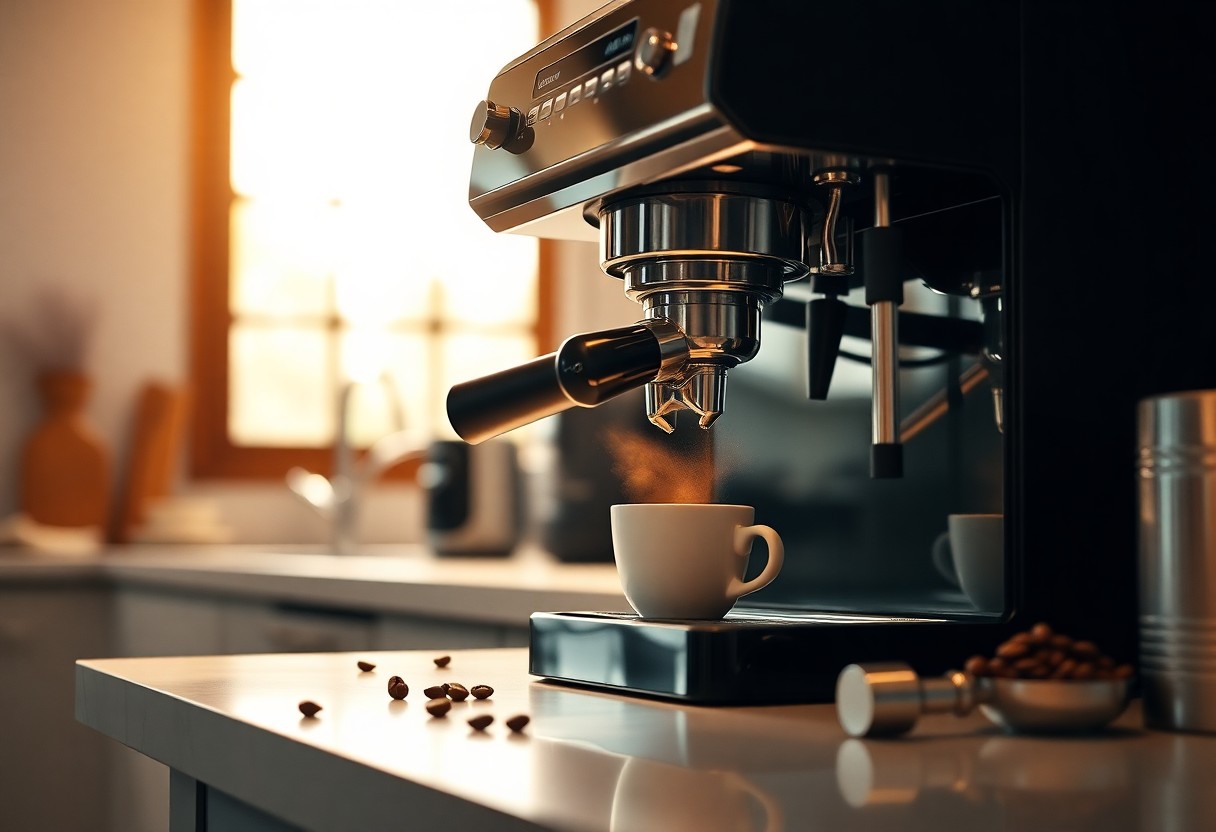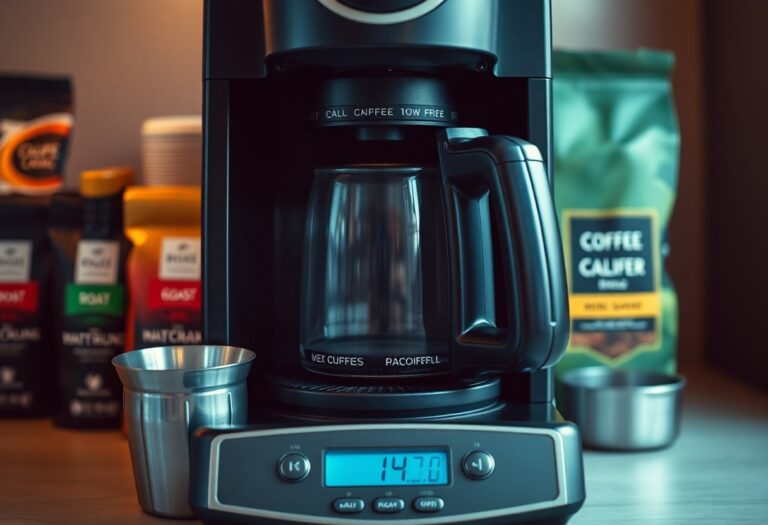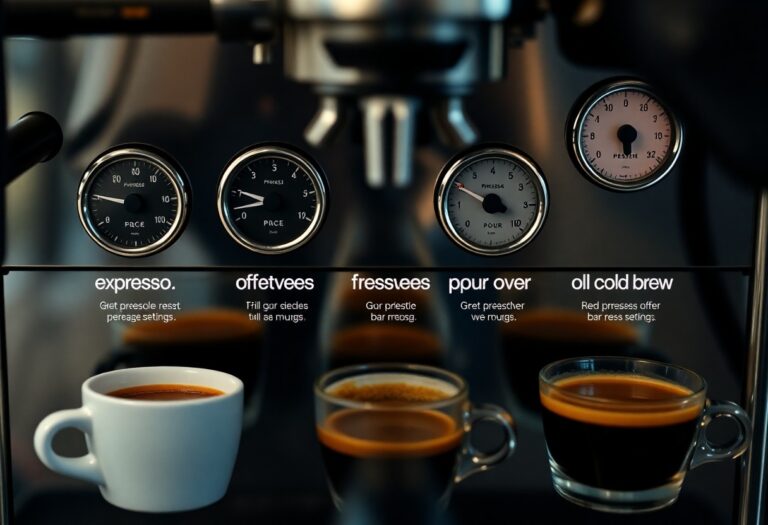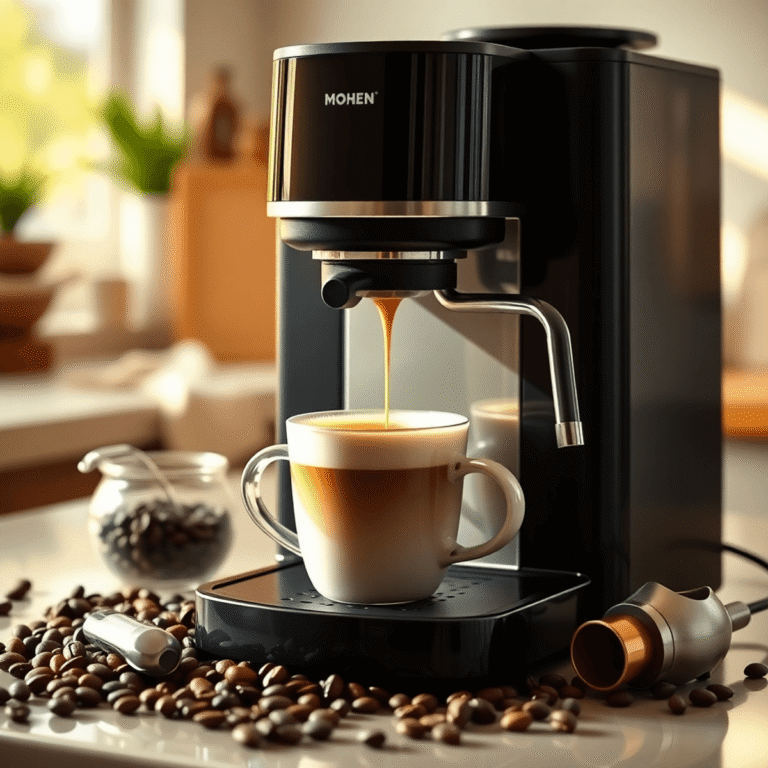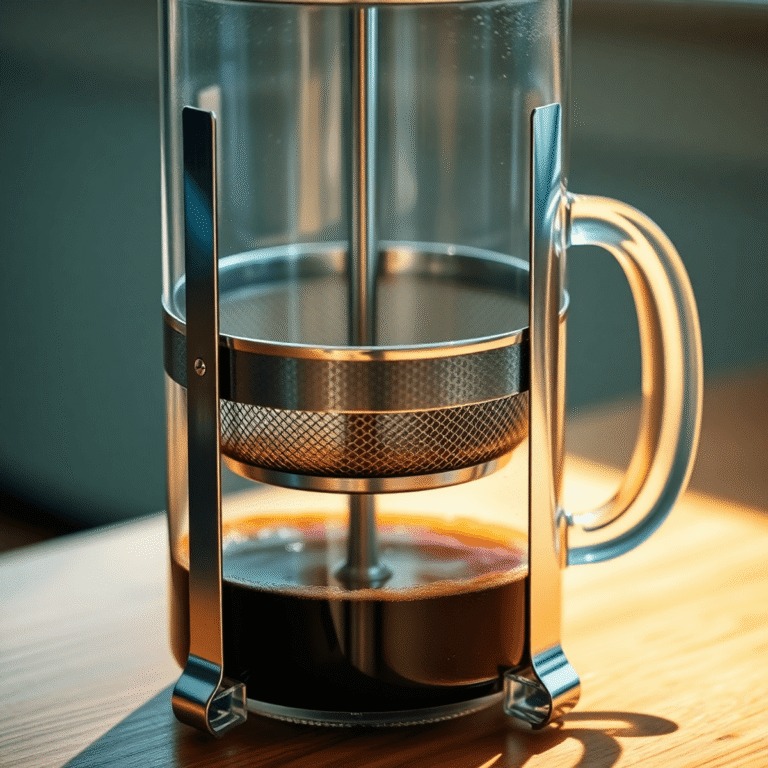Which Coffee Machine is Best for Espresso – Pressure Brewing
With so many options available, selecting the ideal coffee machine for espresso that utilizes pressure brewing can be overwhelming. You want a machine that not only brings out the rich flavors of your coffee but also ensures consistent quality with every shot. Finding the perfect balance between affordability and performance is imperative for getting the most out of your espresso experience. This guide will provide you with key insights on features to consider, helping you make an informed choice to elevate your coffee game.
Key Takeaways:
- Consider the pressure rating: A good espresso machine should consistently deliver 9 bars of pressure for optimal extraction.
- Evaluate types: Manual, semi-automatic, automatic, and super-automatic machines each offer different levels of control and ease of use.
- Look for features: Built-in grinders, milk frothers, and programmable settings can greatly enhance your espresso-making experience.
- Material matters: Stainless steel machines tend to be more durable and retain heat better than plastic counterparts.
- Price vs. performance: Expensive machines may offer advanced features, but several mid-range models perform exceptionally well for home brewing.
Brewing Mechanics: The Art of Pressure Extraction
Understanding the mechanics of espresso brewing involves mastering pressure extraction. This process relies on heated water being forced through finely-packed coffee grounds under pressure, producing a rich, concentrated shot of espresso with a creamy crema on top. Efficient espresso machines utilize high-pressure systems that allow for consistent extraction, ensuring that the flavors are fully realized. For those interested in integrating an espresso machine with other brewing methods, check out The 8 Best Coffee and Espresso Machine Combos, Tested ….
The Science Behind Espresso Pressure
Espresso pressure operates typically at around 9 bars, which is approximately 130 psi. This pressure is necessary for extracting the oils and soluble compounds from the coffee, resulting in a well-balanced shot. Insufficient pressure can lead to under-extraction, creating a weak flavor, while excessive pressure can lead to over-extraction, making the espresso bitter. Achieving this ideal pressure requires precise machine calibration and often relies on high-quality components for optimal performance.
Key Components That Affect Pressure Brewing
Several components directly influence the pressure during espresso brewing, including the pump, boiler, and portafilter. The pump ensures water reaches the required pressure, while the boiler maintains a stable temperature. A quality portafilter is necessary as it holds the coffee grounds and can affect the uniformity of water distribution. Additionally, the design of these components can impact consistency in pressure output, which ultimately affects the taste and quality of your espresso.
The pump type is especially critical; rotary pumps are usually preferred in commercial machines for their ability to maintain stable pressure, while vibratory pumps are more common in home models due to their compact size and lower cost. The boiler type also matters, as dual boilers allow for simultaneous brewing and steaming, providing greater control over temperature and pressure during extraction. Portafilters with varying designs, such as pressurized versus non-pressurized, can influence how water flows through the coffee, impacting flavor extraction. Paying attention to these key components will enhance your espresso brewing experience significantly.
Espresso Machine Showdown: Evaluating Popular Options
In the context of selecting your espresso machine, an in-depth comparison of popular options can steer your decision-making process. Models vary widely in features, cost, and user adaptability. If you seek a comprehensive overview on leading machines, check out The Best Espresso Machine. Each option brings something distinct to the table, ensuring that you can find a machine tailored to your preferences and home setup.
Manual vs. Automatic: Which Type Delivers the Best Brew?
Choosing between manual and automatic espresso machines boils down to the level of control you want. Manual machines give you hands-on power over the extraction process, allowing for precise customization, while automatic machines offer convenience and consistency for users who may prioritize efficiency. If you’re an enthusiast who enjoys honing your barista skills, manual can be rewarding; conversely, if you’re looking for quick results, automatic may suit you better.
Lever and Pump Systems: Pros and Cons of Each
Pros and Cons Comparison
| Lever Systems | Pump Systems |
|---|---|
| Allows for precise control over pressure | Consistent pressure delivery for uniform extraction |
| More affordable options available | Often feature advanced technology |
| Offers a unique, hands-on brewing experience | Greater ease of use, ideal for beginners |
| Requires physical effort and technique | Automatic settings can limit creative control |
| Can create a rich, flavorful shot when done right | Type of coffee and grind can heavily influence taste |
| Less maintenance and simpler design | More parts can lead to higher repair costs |
| Longer learning curve for optimal results | Quick brewing process |
| Can be less consistent without proper skill | Usually come with built-in grinders and features |
| Easily customizable | Less room for experimentation at times |
Lever and pump systems each bear distinct advantages and disadvantages. With lever machines, you gain unparalleled control over your espresso shot, often resulting in a delicious, coffee-forward flavor profile. However, they demand considerable skill to master, which may not appeal to everyone. Pump machines, meanwhile, streamline the brewing process. They deliver consistent results but may not allow for the fine-tuning some passionate coffee drinkers crave. Ultimately, the best choice aligns with your specific tastes and level of experience in crafting espresso.
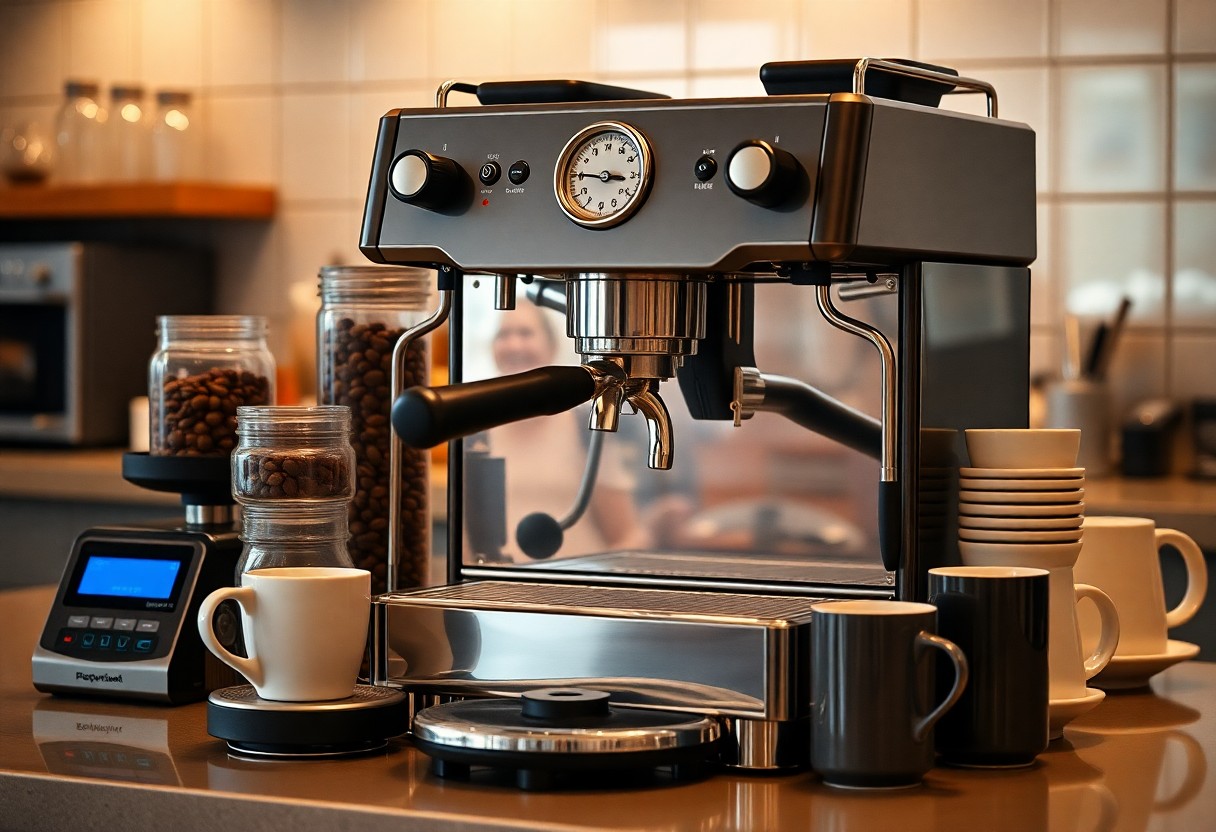
Budgeting for Brews: What You Really Need to Spend
Finding the right espresso machine without breaking the bank requires an understanding of what you’re willing to invest. A quality espresso setup can range from budget-friendly options for beginners to more advanced models for serious enthusiasts. Setting a budget that aligns with your brewing goals will ensure you invest in a machine that meets your needs without compromising on quality.
Price Ranges for Quality Pressure Espresso Machines
Espresso machines can vary widely in price, typically ranging from $100 for entry-level devices to upwards of $5,000 or more for high-end commercial models. In the $300-800 range, you can find decent machines that deliver satisfactory brews, while $1,000+ offers features like better pressure control and automation for serious coffee enthusiasts.
Breaking Down Cost vs. Performance: Is It Worth It?
Investing in a higher-end espresso machine may seem excessive at first, but the performance upgrade can be significant. Machines in the mid to high price range often feature more consistent temperature control and optimal pressure levels, which greatly affect flavor extraction and overall coffee quality. Over time, you could save money on coffee shop visits as you refine your brewing techniques at home.
Many coffee enthusiasts find that the cost difference between entry-level and premium machines translates into a noticeable difference in the brewing process and the final cup. For instance, a $500 machine typically offers better temperature stability, more durable components, and the ability to fine-tune your brew compared to a $100 model. Think about the frequency of your coffee consumption and consider the potential savings on cafe visits, as well as the joy of crafting cafe-quality espresso in your own kitchen, making the investment more appealing over time.
Maintenance Matters: Keeping Your Machine in Top Shape
Taking care of your espresso machine is key to ensuring it produces high-quality brews consistently. Regular maintenance not only prolongs the life of your equipment but also prevents brewing inconsistencies that can spoil your coffee experience. A well-maintained machine will operate more efficiently, saving you both time and potential repair costs down the line.
Routine Cleaning and Cycle Maintenance
Performing routine cleaning after each use minimizes coffee residue buildup, keeping your machine functioning optimally. You should flush water through the group head and steam wand, and wash the portafilter and baskets regularly. Besides daily cleaning, weekly cycle maintenance is necessary; this includes backflushing your machine if it has a three-way valve. Investing a bit of time in this process will enhance your espresso’s flavor and aroma.
Troubleshooting Common Issues with Espresso Machines
Espresso machines may present a range of issues, from water leaks to inconsistent shots. Assessing these problems can be as simple as checking the water reservoir or ensuring the portafilter is locked in place. If you encounter any strange sounds or error messages, refer to your machine’s user manual for guidance. Regular troubleshooting and minor repairs can save you from costly service calls.
Common troubleshooting often involves checking for clogs, particularly in the steam wand or group head, which can drastically affect performance. Ensure that the water temperature is appropriate—it should be around 190°F to 205°F for optimal extraction. If your espresso tastes bitter or weak, it might be due to stale beans or incorrect grind size. Listening to your machine can also be an indicator; unusual sounds may signal a need for professional servicing. Keep notes on recurring issues to track patterns that might require your attention.
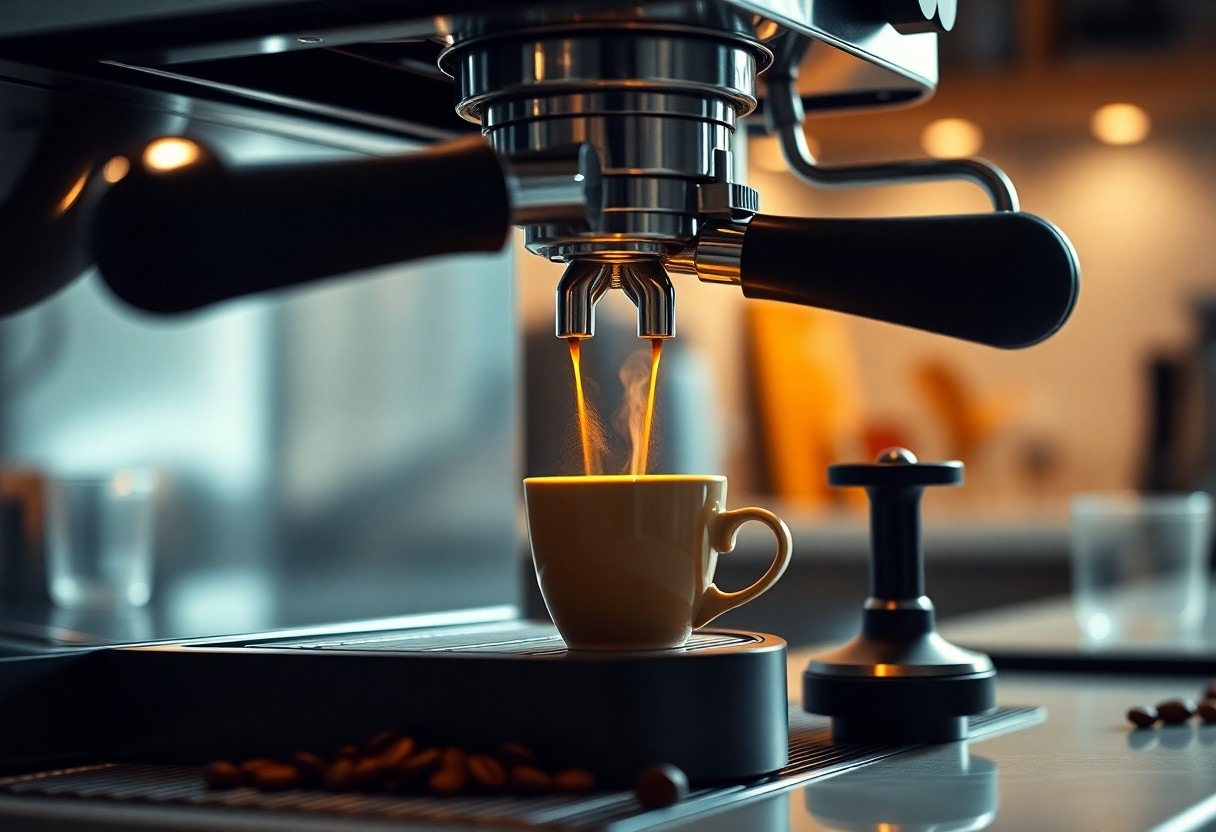
Expert Insights: Barista Tips for the Home Brewer
As you hone your skills, consider these expert tips for crafting the perfect espresso at home. Grind size is crucial; aim for a fine grind that feels like table salt for optimal extraction. Monitor your water temperature – ideally between 90°C to 96°C (195°F to 205°F) to avoid bitterness. Use a scale to measure your coffee dose precisely, typically around 18-20 grams for a double shot. Lastly, practice tamping evenly and with consistent pressure to enhance your espresso’s crema and flavor profile. Any adjustment you make can lead to a significant improvement in your brewing process.
Enhancing Your Home Espresso Experience
Incorporating a few simple practices can transform your home brewing ritual into an extraordinary experience. Start by investing in quality equipment like a reliable espresso machine and a sturdy grinder. Upgrade your tools further by using accessories like a tamper or milk frother, which can elevate both the quality and presentation of your drinks. Additionally, consider experimenting with different beans and origins to discover new flavors and aromas that suit your palate perfectly.
The Role of Fresh Ingredients in Pressure Brewing
Quality ingredients play a pivotal role in the outcome of your pressure brewing. Freshly roasted coffee beans give you vibrant flavors that stale beans simply can’t match. Opt for whole beans and grind them just before brewing for maximum freshness. The water quality is equally important; use filtered water to avoid impurities that can affect your espresso’s taste. Lastly, don’t overlook the effect of milk or milk alternatives. Fresh, high-quality options will create a better texture and flavor in your lattes and cappuccinos.
Using fresh ingredients directly influences the taste and quality of your espresso. For example, coffee beans lose their flavor profile quickly after roasting; therefore, purchasing fresh beans means more pronounced and complex flavors. Ideally, coffee should be used within two to four weeks of roasting for the best results. Regarding water, using filtered or bottled options removes any unwanted chemicals that tap water may contain, enhancing the overall taste of your espresso. Fresh milk or alternatives also create better foam and balance, elevating your drinks to a café-quality experience at home.
Conclusion
The best coffee machine for espresso will depend on your specific needs and preferences, but focusing on pressure brewing options is crucial for achieving that rich and flavorful shot of espresso. Consider factors such as ease of use, consistency, and maintenance when making your choice. Whether you opt for a manual, semi-automatic, or fully automatic machine, investing in quality equipment will elevate your espresso experience, allowing you to enjoy café-style beverages right in your home.
FAQ
Q: What features should I look for when selecting an espresso machine that uses pressure brewing?
A: When choosing an espresso machine, consider the following features:
1. Pressure System: Look for machines that operate at 9 bars of pressure for optimal espresso extraction.
2. Temperature Control: A good temperature control system helps in maintaining consistent brewing temperatures.
3. Build Quality: Opt for machines made from durable materials such as stainless steel for longevity.
4. Ease of Use: Consider user-friendly interfaces and easy-to-access maintenance options.
5. Frothing Capability: If you enjoy lattes or cappuccinos, check for a quality steam wand or automatic frother.
Q: Are automatic espresso machines better than manual ones?
A: The choice between automatic and manual machines depends largely on your preferences:
– Automatic Machines: They are convenient for quick and consistent brewing, often suitable for beginners. Many come with built-in grinders and frothers.
– Manual Machines: These offer full control over the brewing process, allowing for customization of variables like grind size and extraction time, appealing to espresso enthusiasts and those who enjoy the art of coffee making.
Q: How much should I expect to spend on a quality espresso machine that utilizes pressure brewing?
A: The price range for quality espresso machines varies widely. For a decent home machine, you can expect to spend anywhere from $300 to over $2,000. Factors affecting price include the machine’s materials, brand reputation, brewing capacity, and additional features such as grinders or milk frothers. It’s advisable to invest in a quality machine that fits your budget to ensure durability and performance.
Q: Do I need to buy a separate grinder for espresso brewing?
A: While it’s not a requirement, having a high-quality grinder is recommended for optimal espresso brewing. Freshly ground coffee enhances flavor and aroma, and a burr grinder is preferred for its ability to provide a consistent grind size necessary for pressure brewing. Some espresso machines come with built-in grinders, which can save on counter space and offer convenience.
Q: What maintenance is necessary for a pressure-brewing espresso machine?
A: Regular maintenance is important to prolong the life of your espresso machine and to ensure great-tasting coffee. Essential maintenance tasks include:
1. Cleaning: Regularly clean the portafilter, steam wand, and drip tray to prevent residue build-up.
2. Descaling: Every few months, descale the machine using a suitable descaling solution to remove mineral deposits.
3. Changing Water Filters: If your machine uses a water filter, replace it as recommended by the manufacturer to maintain water quality.
4. Checking Seals and Gaskets: Inspect these parts frequently and replace them if they show signs of wear to avoid leaks.

